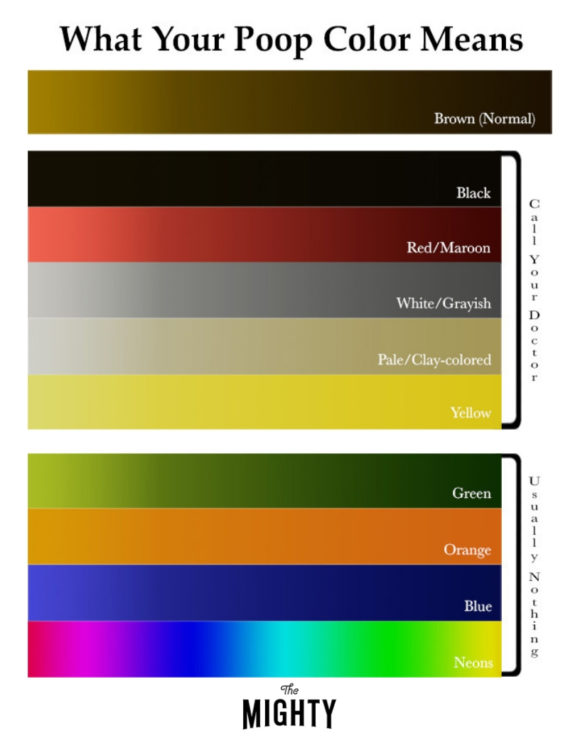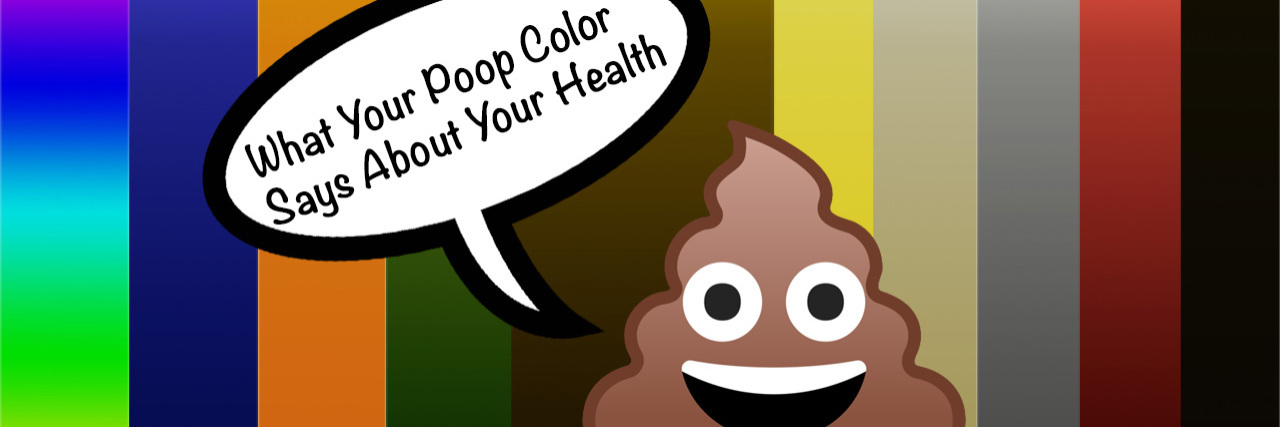It’s the question we’re all secretly looking up online in an incognito browser when we’ve seen something fishy in the bathroom — “What does my poop color mean?” There’s good reason to ask. Your stool color can tell you (and your doctor) a lot about your health, digestive or otherwise, including conditions like hemorrhoids, bile duct obstructions, inflammatory bowel disease and celiac disease.
While most poop colors, even the brightest, wildest pinks and blues, may seem alarming at first, there’s really only four poop color families you’ll want to watch out for. So without further a-doo-doo, here’s everything you need to know about poop color and your health.
 (Click here for a downloadable version of the chart.)
(Click here for a downloadable version of the chart.)
Normal Poop Color
By now you’ve probably noticed that most of the time your poop color is a shade of brown. Whether it’s darker to lighter brown, this is normal. Brown stool is the work of a healthy process in the gastrointestinal (GI) tract. It starts when food enters your mouth. Once food is chewed, it travels through a soft pipe called the esophagus until it reaches your stomach. Food in your stomach gets mixed with acid and enzymes to break down food particles.
Next, the processed food travels into your small intestines where enzymes from your pancreas and a greenish bile from the liver (by way of the gallbladder) are added into the mix. Your small intestine processes and absorbs nutrients and then passes the leftover waste into the colon (also called the large intestine). Here, after water is removed, the stool is stored until it’s passed out of the body. During a healthy version of this process, digested food, acid, enzymes and bile mix together and the result is normal brown-colored stool.
Poop Colors That Could Mean a Health Problem
While your stool can be a variety of colors, according to Marc D. Makhani, MD, a gastroenterologist and founder of LA Digestive Health and Wellness in Beverly Hills, Calif., there’s really just four poop color palettes that are of concern for adults — red, black, clay-colored or gray and yellow. These stool colors serve as a clue to many health problems you may have, and you’ll want to call the doctor if you see these colors.
Red or Maroon
 As you can probably guess, red in your stool indicates bleeding somewhere in your GI tract. “A lot of times when it’s a brighter red that can be more indicative of a hemorrhoidal bleed,” Makhani told The Mighty, or it could be a bleed “a little higher up in the colon.”
As you can probably guess, red in your stool indicates bleeding somewhere in your GI tract. “A lot of times when it’s a brighter red that can be more indicative of a hemorrhoidal bleed,” Makhani told The Mighty, or it could be a bleed “a little higher up in the colon.”
If you live with an inflammatory bowel disease like ulcerative colitis or Crohn’s disease, you’re more likely to experience red stool at some point. These conditions cause inflammation in the GI tract that can cause tears in the intestine lining or ulcers, both of which may bleed. Red stool can also be an indication of diverticulitis, a condition that causes pouches in your colon and inflammation.
Seeing a lot of blood in the toilet, Makhani said, is worth a trip to the emergency room as red stool indicates additional attention is needed. Call your doctor right away. It’s worth noting that red stool can also be caused by eating foods with high levels of artificial red dye, red natural foods like beets or cranberries and some medications.
Black

Black stool can also indicate bleeding and requires immediate contact with your doctor. When it’s a tarry consistency, black stool is called melena. It can be the result of bleeding in the upper intestinal tract, like the stomach or upper small intestines, Makhani said. Blood mixes with acids from the upper part of the GI tract and it comes out as black poop.
Other causes may include some medications with the ingredient bismuth (like Pepto-Bismol) and foods with dark artificial colors like licorice or grape juice. Sometimes dark green poop, a color caused by bile that isn’t usually as big of a health concern, can look black at first glance.
Pale, Grey and Clay-Colored

Light-colored poop, like shades of grey, white or a clay color, should also be reported right away to your doctor. When bile, which is a greenish-yellow color, isn’t released properly during the digestive process, it doesn’t have a chance to mix with the rest of the waste in your system. Without bile in the mix, your poop won’t come out brown but one of these lighter colors.
Called acholic stools, light-colored waste may indicate a bile duct issue, such as a gallstone, liver infection or a pancreas or gallbladder tumor, because bile isn’t being released in the GI tract during digestion. If you’ve recently had a barium swallow test, it’s normal to have white-ish stool immediately after.
Yellow

If you see yellow poop, this may be an indicator of celiac disease. Those with a gluten intolerance, however, may have yellow or brown poop. “There’s really no hallmark for that condition,” Makhani said. Your stool may be yellow because it contains an excess of fat, likely due to a malabsorption disorder, like celiac disease, that doesn’t absorb as much fat during the digestive process. Yellow stool can also be caused by a parasite. If it persists for more than a couple of days, it’s best to check in with your doctor.
What to Do If You’re Worried
If you’ve noticed your stool is any of these worrisome colors — shades of red, black, pale-colored or yellow — call your doctor, but try not to panic. While all of these poop colors warrant further investigation, there could be innocent reasons for the discoloration. Your doctor should take a full, detailed health history in order to determine what might be going on to rule out benign causes such as your diet, artificial food coloring or medications.
“Pepto-Bismol tends to make stool very dark, almost similar to the melena,” Makhani told The Mighty as an example of why a full-health history is important. “Someone will get concerned and say their stool is black and worried about bleeding, but when you talk about their history [you] find out they used Pepto-Bismol.”
“I’m a fan of communication between patients and their healthcare providers,” he added. “It’s better to be overly cautious in my opinion than to ignore it and have something bad happen.”
Other Poop Colors
Inevitably, you may wonder about all the other poop colors you’ve noticed. Though they may give you pause, in general, the following colors are not a cause for concern. But, as Makhani suggests, you can always reach out to your doctor if you’re worried, especially if you’ve noticed the change in stool color lasts more than a few days or you have other symptoms.
Green

Green is a common alternative poop color you may see from time to time. This generally isn’t something to worry about. “We don’t really know what the clinical significance of that is,” Makhani said. “It might be as simple as dietary changes.”
Green stool can be caused by eating a lot of leafy vegetables or artificial food coloring. It may be the result of waste moving too quickly through your system before bile and bilirubin (another chemical from the liver) have a chance to break down completely so you’ll see more of their coloring in the greenish poop. Iron supplements may also lead to a green color.
Orange

Orange poop generally isn’t a cause for concern either. It’s most likely triggered by foods rich in beta-carotene like sweet potatoes, carrots, pumpkin and squash. Antibiotics or over-the-counter antacids that contain aluminum hydroxide have also been known to cause orange-colored waste. In some cases, poop may be orange because of a lack of bile during the digestive process as well. Orange poop can also be a symptom of acid reflux (GERD).
Blue

Yes, your poop can even come out in shades of blue, though it’s not a common occurrence for most people. You can thank blue foods or drinks, particularly ones with artificial colorings, for your blue poo. The faster the blue dye moves through your system, the more likely it is your poop will look blue.
Pink and Other Neon Colors

Artificial coloring in your food can turn your poop any shade on the color wheel, including neons. Peep-flavored Oreo cookies with a hot-pink frosting, for example, turned some people’s poop pink. (No joke.) In another instance, Burger King’s limited edition Halloween burgers with a black bun caused others to experience neon green poop.
Long story short, if you’ve got a poop color that’s rainbow bright, it’s most likely the result of an artificial food additive that your body isn’t made to digest. It passes quickly through your system and works its dye magic a No. 2 time.

